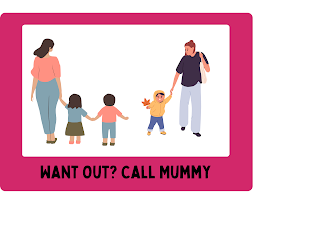Safe and Sound: Teaching Your Non-Verbal Child to Stay Close and Understand Danger
As a parent of a non-verbal autistic child, I know how important it is to teach our kids about safety, especially when it comes to preventing them from wandering off. The world is full of fascinating things that can easily capture their attention, but understanding the dangers that come with wandering is crucial. So, where do we start, and how can we teach this in a way that's simple, clear, and not overwhelming for both us and our kids?
In my last blog post, I discussed tech tools like GPS watches, AirTag holders, alarms, and trackers to help locate our kids if they wander off. These are fantastic preventive measures, but technology alone isn't enough. We need to reinforce safety behaviors through consistent, clear, and engaging teaching strategies.
Starting from the Basics: A Three-Part Series
In this series, I’ll share simple routines and strategies that you can use to reinforce safety behaviors in your non-verbal autistic child. Visual aids, social stories, and role-playing are key tools in making these concepts easy to understand and remember. As a visual learner, my son Ash responds well to these methods, and I've seen firsthand how effective they can be.
1. No Running
One of the first concepts I taught Ash was "No Running." I created a simple visual aid using Canva: a picture of a child running with the words "No Running" underneath. This visual, combined with role-playing, helps reinforce the idea. I show Ash the picture and say, "No Running." Then, I ask him to repeat it and show him the picture again.
To take it a step further, I involve the whole family in a role-play scenario. We demonstrate running, then stopping when someone says "No Running," reinforcing the words with actions. You can practice this at home or even take it outside to simulate a real-world situation.
2. Stay with the Teacher
Another strategy close to my heart is teaching your child to stay with their teacher. I created a visual aid with a picture of Ash's teacher holding his hand and the words "Stay with Teacher Camelia." If your child has different teachers, you can make one for each, using their names to personalize it.
This visual aid can be reinforced daily or weekly, reminding your child to stay close to their teacher. If possible, ask the teacher to participate in a role-play exercise, showing your child what it means to stay with them in various scenarios.
3. Ask Before Going Out
Children are naturally curious, and certain places like parks or pools might be especially tempting. To prevent wandering, I created a visual that says "Want Park? Call Mummy" or "Want Out? Write Out." This teaches Ash that before leaving the house, he should come to me or write the simple words "Out" or "Park."
Role-playing this scenario with family members helps reinforce the behavior. We simulate a situation where Ash might want to leave, and we practice asking first. Over time, this practice helps build a habit of asking before heading out.
4. Stay with the Group
Finally, it's essential to teach our children the importance of staying with a group during outings or excursions. I created a visual that shows a group of kids together, with one child wandering off and a bold "No" written next to it.
We practice this concept during family outings by lining up the kids, turning Ash away from the group, and saying "No" when he tries to wander. Then, we have everyone hold hands and say "Yes" as they stay together. This role-playing helps reinforce the need to stay close and stick together, whether at the park, on a walk, or during any group activity.
These simple strategies might seem small, but they can make a big difference in how your child understands and reacts to the world around them. By using visual aids, social stories, and role-playing, you can help your child grasp the importance of staying safe and close, even when something interesting catches their eye.
Try these methods at home, and you'll see how they can change the way your child views safety. Together, we can help our kids navigate the world more safely and confidently.
Best Wishes,

.png)

.png)
.png)
.png)



Thank you so much for this!! Great read.
ReplyDelete